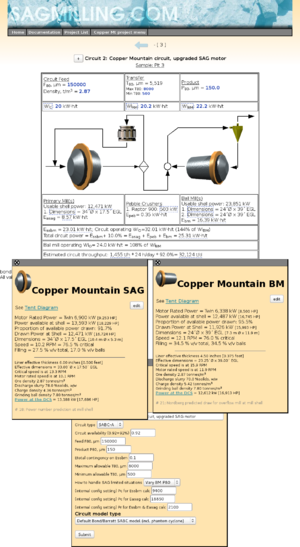Difference between revisions of "Benchmarking: Bond - Copper Mountain"
(Created page with "category: Benchmarking category: Bond/Barratt Model ==Benchmarking: Bond/Barratt - Copper Mountain== ===2011 SAG Conference, Mill & Motor=== ''van de Vijfeijken, ...") |
(No difference)
|
Revision as of 05:16, 3 December 2012
Contents
Benchmarking: Bond/Barratt - Copper Mountain
2011 SAG Conference, Mill & Motor
van de Vijfeijken, M., Filidore, A., Walbert, M and Marks, A., Copper Mountain: Overview on the Grinding Mills and their Dual Pinion Mill Drives. Proceedings of the SAG 2011 Conference, September 25-28, 2011; Vancouver, Canada.
- SAG mill inside (shell) diameter: 34 ft (10.363 m)
- SAG mill effective grinding length: 17.5 ft (5.334 m)
- SAG mill design speed (corresponding to motor peak torque/power): 10.08 RPM
- SAG mill motor (original) power output: 17,000 HP (12,677 kW)
- Ball mill inside (shell) diameter: 24 ft (7.315 m)
- Ball mill effective grinding length: 39 ft (11.886 m)
- Ball mill design speed (corresponding to motor peak torque/power): 11.89 RPM
2011 SAG Conference, Process Design
Marks, A., Sams, C. and Major, K., Grinding Circuit Design for Similco Mines. Proceedings of the SAG 2011 Conference, September 25-28, 2011; Vancouver, Canada.
| Sample | Density, g/cm3 | A×b | ta | WiRM | WiBM |
|---|---|---|---|---|---|
| Pit 2 | 2.75 | 22.9 | 0.19 | 20.1 | 22.3 |
| Pit 3 | 2.87 | 20.1 | 0.16 | 20.2 | 22.2 |
- Circuit F80: 150 mm
Presentation to District 6 CMP
Morrison, R., Current Plant Conditions at Copper Mountain. Presentation to the BC/Yukon Branch Canadian Mineral Processors, November 29, 2012; Vancouver, Canada.
- Ore blend is 80% Pit 3; 20% Pit 2.
- SAG mill motors have been upgraded to total 13.8 MW by adding cooling to drive transformers (6.9 MW per motor).
- SAG mill operating with 17% v/v ball charge and 27% to 28% v/v total filling
- SAG mill operating typically 10.2 RPM.
- Ball mills operating 34% to 35% v/v total filling
- Circuit P80=150 µm (was 180 µm before SAG motor upgrade)
- Circuit throughput: 1600 t/h
Modelling
- Assume the crushing work index is similar to the rod mill: 20 (metric).
- Default SSBM contingency for SABC circuit is 0.10.
- Assume liner thickness of 6 inches in SAG, 4.5 inches in ball mill.
- Model predicted throughput: 1462 t/h on Pit 3 ore and 1452 t/h on Pit 2 ore
Result for default model conditions:
| Tonnage | |
|---|---|
| Model | 1462 t/h |
| Measured | 1600 t/h |
| Difference | 138 t/h |
| Difference | 9.0% |
Discussion
- It is noted that the SAG mill model is drawing less than 92% of available power and the ball mill model is drawing over 95%. The ball mills are likely operating at close to this power draw, but it is likely the SAG mill actual power draw (measured at the shell) is higher than 92%. Power measurements for these mills haven't been published to check against the model.
- The liner effective thickness is unknown and may be thinner than assumed — this would increase the power draw in the mills and increase the tonnage.
Model Tuning
The Bond/Barratt model is tuned using a contingency on the Single Stage Ball Mill specific energy consumption estimate (Essbm).
- The SSBM contingency factor would be back-calculated as 0.01 based on the data set above.
- Changing the SAG mill to the simplified Morrell model results in a much lower mill power draw estimate: 82.8% of rated output. This is much too low and this mill must be modelled with a higher k-factor; likely between 1.35 and 1.40. Unfortunately, without actual motor power measurements, this factor cannot be tuned.
